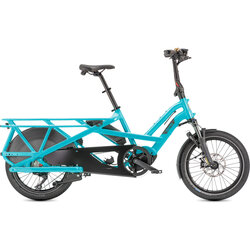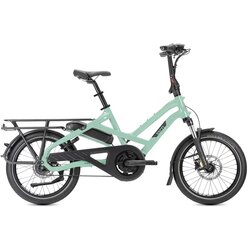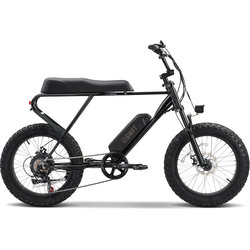How to Care for your eBike Battery
eBike Battery Care FAQs
Your e-bike is a wonderful, enabling tool meant for everyday use. There's no need to fear using your battery. You may have even purchased your bike specifically because of its range, so ride it and don’t sweat it. A quality lithium ion battery will prove reliable even if you regularly push its limits. That said, there are things that can extend or reduce your battery’s life over hundreds of charge cycles, so we did the research and distilled it down to a few key habits and situations to avoid in order to help you get the most out of your e-bike.
What’s the best way to charge (or not charge) my eBike battery?
Is it better to run a battery all the way down to 0%, or to top it off after each ride?
- Short answer: Neither. Treat it like a gas tank; don't let it get so low that you're nervous about running out, and don't bother topping it off above 50% unless you need to. That said, do what you gotta do to get where you gotta go.
- Long answer: Partially charging a lithium ion battery between 20% and 80% is the best way to maintain its total capacity for as long as possible. This is different from the days of NiCad and NiMH batteries, when there was a risk of losing capacity if the battery was repeatedly recharged after being only partially discharged, but lithium ion batteries do not have a memory effect. Even though battery durability is often stated in terms of total charging cycles, it’s the stress of charging that degrades your battery’s capacity. When a battery is near the extremes of 0% or 100%, the charging process is far more lengthy and stressful than in the middle of its range.
Running a battery all the way down (complete discharge) and recharging it fully will reduce your total amount of charge cycles, but will also mean that every charge cycle goes through the two most stressful portions, which are 0 to 20% and 80 to 100%. It’s fine to do when you’re getting the most out of your bike and pushing the battery’s range, but if your routine allows it, partial charging will keep your battery’s stress levels low and capacity high. For example, if your commute is 20 miles one way, and your battery (on an average day) gets 40 miles on a complete charge, we’d recommend buying an extra charger to keep at work so that each one-way commute takes your battery between 80 and 30%. On the other end, if your commute is ten miles round trip and your battery gets 60 miles on a complete charge, top it off at the end of your five-day work week instead of every day, because...
Topping off a battery after each use has a couple of risks. The first is a reduced capacity over the life of the battery due to the repeated stress of charging past ~80%, which takes much longer than the rest of the charging cycle. The second is that batteries are much more vulnerable to heat damage when they are fully charged. In extreme cases, the excess voltage can be a battery killer. Topping off a battery when needed is always fine, especially if you’re careful with charging and storage temperatures. If, however, your situation allows you to take multiple short trips on a single charge, waiting until the battery is between 20 and 40% to top it back off can extend your battery’s life by reducing the overall number of charge cycles, and the amount of time spent charging near 100%.
What temperatures are safe for charging, using, and storing my eBike battery?
Short answer: It's comfortable when you are. Just like us, e-bikes can tolerate a fairly wide range of temperatures for short times, but are best kept inside an optimal range for the long term.
- Ideal: 40 to 70F (5 to 20C)
- OK: 30 to 85F (0 to 30C)
- Extreme: 15 to 120F (-10 to 50C)
Temperature during use: Risk of damage increases as a factor of how severe the temperature is, and how much time is spent at that temperature. Any time spent beyond the extreme range can be very detrimental. Pushing a battery towards the edge of the "OK" range is very unlikely to cause failure, but it will diminish a battery’s life more quickly than operating inside the ideal range. Keep in mind that a dark battery case in direct sunlight can make a battery heat up to much more than the ambient air temperature.
If you live in a city like Denver that regularly sees temperatures listed outside the "OK" range of 30 to 85 degrees, how you store and charge your battery is more important than whatever the temperature happens to be when you're riding.
Temperature during storage: Optimal storage is 40 to 50% charge, between 40 to 60 degrees F, but room temp is fine. Two situations are particularly destructive: storage below 30F with low charge, and storage above 80F when the battery is above 80% charge. In the former case, the battery can passively self-discharge down to irreparable levels. In the latter case, particularly near 100%, increased battery temperature can cause excessive voltage, which can cause a battery to enter a protective shut-down to avoid exploding. Remember that dark battery casings and car interiors can heat up well above ambient air temperature. Keep this in mind when driving with a fully-charged battery to a riding destination.
Temperature during charging: Charging prefers warmer temperatures than storage, so room temperature is perfect. Charging a cold battery can damage cells, so it's best to let your battery warm up after a winter ride before plugging it in. Charging while warm (not hot) isn't inherently dangerous, aside from the above storage considerations.
Should I store/charge my eBike battery on or off the bike?
Temperature is the main consideration here. Charge your battery in a location that allows you to get as close to room temperature as possible. For long-term storage, since a charge of 40-50% is ideal, it's best to keep your battery off the bike, since background drains can slowly discharge a battery. Plug it in (or at least check charge level) every 3-4 months, but don't leave it on the charger for a long time! Storing at 100% degrades cells more quickly than storing at 40%.
Overall, it's better to use a battery and keep it in the middle of its charge levels (even in hot or cold weather) than to store it improperly, so get out and ride your bike!
Should I store my eBike battery on the charger?
No! Leave it on the bike (unplugged) for short term, off the bike for long term. Modern chargers are smart, and will not "over-charge" a battery, but leaving a battery plugged in can be harmful for other reasons:
- Charging a battery up to 100% takes much longer and is more stressful than the rest of the charge cycle.
- Even a partial charge counts as a charge cycle, which is how battery lifespan is measured
- Storing a battery at 100% degrades cells more quickly than storing a battery at 40-50%, even at room temperature, and can cause the battery to enter a protective shutdown if it gets too hot.
For this reason, we also recommend using a simple outlet timer, so you can set it and forget it. Charging time varies, but often 1 hour is enough to get you most of the way there, and 3-4 hours is typical for a medium capacity battery at room temperature to get from 0-100% (Although try to avoid doing this every day if you can!)
I heard it's recommended to completely charge and then discharge a battery every once in a while. Is this true?
Some manufacturers recommend taking a battery through a complete charge and discharge cycle every 3 months or so. This is a method for recalibrating your estimated range, which your display unit calculates based on data that comes from the battery controller, and has nothing to do with the battery's health or resetting the battery’s memory effect (which is not an issue for lithium ion).
Is it bad to run an eBike battery down all the way?
No, just make sure to charge it up afterwards. If it were harmful to use your entire range, manufacturers wouldn't let you do it. 0% charge, when the cells enter sleep mode, is very different from the cells being completely devoid of voltage. There is, however, a threshold below which batteries can't recover, and since lithium ion cells self-discharge at a rate of 3-5% per month, it's important not to leave a battery empty for a long time, especially in cold (below 40F) temperatures.
If your battery dies due to cold temperature, let it warm up to room temp, then charge it up to at least 40%. 100% is also OK if you plan on using it again soon.
I'm not getting the range that my eBike estimates. Does this mean my battery is degraded?
Possibly, and we can check for that. However, there are numerous factors that affect an e-bike's range outside of battery capacity, including temperature, terrain, assist level used, rider and cargo weight, wind/aerodynamics, bike efficiency, stopping and starting, gear selection, and rider pedal input. Additionally, your display unit could require calibration (see above), or your system might need a firmware update.
Can my battery's capacity be tested, and do you repair or recycle bad batteries?
This one depends on your bike. If you have a Bosch, Shimano, Ebike Motion (Orbea and others) or Yamaha (Giant) system, we can check your battery's health through your bike's onboard diagnostics and source a replacement if needed. If you have a battery from another brand, we no longer offer diagnostic services or battery rebuilds, but can refer you to local options that may even leave your battery better than new. We are in the process of launching our recycling program and will update with more information soon.
Schedule an eBike battery checkup and firmware update
Why do bikes use Lithium Ion Batteries?
A few things make Lithium Ion (Li-Ion) batteries ideal for eBikes, until something better comes along:
- Li-ion batteries have higher specific energy and energy density (energy per mass and volume, respectively) than other common battery types, both of which matter when it comes to making a sleek and lightweight eBike.
- Li-ion batteries have a low self-discharge rate, so they’re ready when you are.
- Li-ion batteries have no memory effect, meaning there’s no risk of losing capacity if the battery is repeatedly recharged after being only partially discharged. (More info on charging cycles and durability can be found above)
| Li-Ion | NiMH | NiCd | Lead Acid | |
| Specific Energy (Wh/kg) | 100-265 | 60-120 | 40-60 | 33-42 |
| Energy density (Wh/L) | 250-700 | 140-300 | 50-150 | 60-110 |
| Specific Power (W/kg) | ~250-340 | 250-1000 | 150 | 180 |
| Cycle durability (cycles) | 400-1200 | 180-2000 | 2000 | <350 |
| Self-discharge (/month) | 3-5% | 30% | 15-20% | 4-6% |
Will my e-bike battery explode?
Realistically, no. Even if it's made by Samsung. Batteries from reputable manufacturers (which are the only ones we sell) are extensively idiot-proofed. If you manage to do something so idiotic that even teams of engineers, testers, and standard-writing government bureaucrats couldn't anticipate it, well... congratulations.
Oh, and if your battery is in your down tube, and your frame came with spacers installed under the bottle cage bolts... use them. Alternately, stop turning the wrench when you reach the kind of torque that feels like it could pierce through a battery casing.












